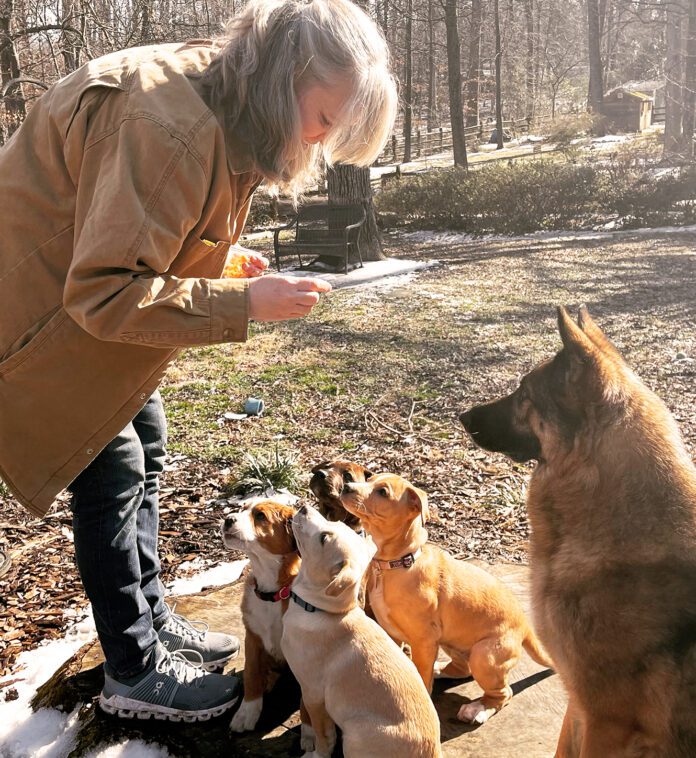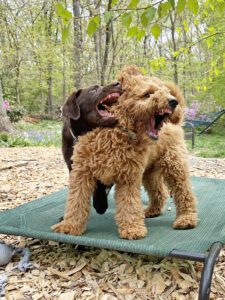
Creating the right canine social circle for your puppy in the first few months of his life will pay incredible rewards. Your pup will be happier, much easier to be around, and primed to be the kind of adult dog who gets along with other dogs.
Puppies thrive when they can interact with their own kind — like-minded individuals who understand that it makes sense to sniff each others’ privates or play a bit of bitey-face. After all, we’ve taken them from their wrestling, chasing, jumping littermates and plunked them down on Planet Human. That transition is much easier if they have some fellow travelers.
Be careful, though, because for the youngest of puppies, interacting with other dogs does carry risk. In the key “socialization window” before the age of four months – during which it is critically important a puppy experiences new things in a way that feels positive – the distemper/parvo vaccination series is not yet complete. That’s a challenge, because being around a sick dog at that point could mean catching a life-threatening disease
As scary as that sounds, making nuanced choices to avoid disease is actually the easy part of getting dog-to-dog socialization right. (See “Balancing Dual Threats: Protecting puppies against viral disease and behavioral problems,” WDJ October 2022.) The trickier truth to navigate is that perfectly healthy dogs can pose a risk to puppies, too. They might hurt the pups physically, or they may simply scare them with their exuberance, rough play, or vocalizations. That psychological impact can be particularly damaging during the sponge-like sensitive period before four months of age.
If you’re thinking it would be much easier to just wait until later when the puppy is fully vaccinated and not so easily imprinted upon . . . that’s a mistake! Once the socialization window closes, biology will be working to tell a puppy that if they haven’t experienced something yet, it could be a threat. That’s why a pup who’s sheltered away from other dogs until emerging fully vaccinated at five months can be forever unable to feel truly comfortable around dogs.
So, yes, it takes effort to do it right, but it’s worth it. Plus, doggy interactions are actually a very fun part of socializing a puppy. Just get yourself up to speed on how to plan a safe and positive experience, and you’re on your way to seeing a whole new side of your pup.
The Benefits of a Puppy Playdate

If you have a puppy who is super mouthy, please put “find a great puppy playmate” at the top of your to-do list. If you – or your young kids – are having trouble landing on a pain-free way to interact with your baby alligator, the puppy playdate can be a godsend.
A little half-hour romp with the neighbor’s puppy can do four giant things:
- Give your puppy a natural outlet for those mouthy impulses
- Truly tire her out, which results in a puppy who’s no longer all teeth
- Build your puppy’s doggy communication skills
- Teach the very important “bite inhibition” that will make her an adult dog who’s safer to be around
Safe Playmates, Good Set-Ups
To find the right playmate, think safety first. Look for well-informed humans who are responsible, and who keep their not-fully-vaccinated-yet puppy away from unknown dogs and the places they frequent (like dog parks). Have a chat about how crucial it is to cancel any playdate if a puppy isn’t in tip-top shape that day.
Once you have a puppy playdate scheduled, think about the location. You want to set things up so that each puppy feels safe, and has the ability to choose whether to interact or not throughout the whole playdate. The environment can help a great deal with this, so arrange for your yard or room to have hiding places and obstacles that slow play and offer a breather (benches, bushes, couches or low tables to go over and under). If, instead, you offer just an empty square, it will usually end up with one puppy feeling cornered and scared, which is the opposite of what we’re trying to accomplish.
When and How to Intervene

Even with a great set-up, you’ll need to intervene at times. The key is knowing when and how. Especially in the beginning of the playdate, you may see some behavior that means the pups need some help figuring out how to play well together: maybe one pup is repeatedly standing stiffly over another, or there’s some wrestling that turns into a very vocal, snappy skirmish. Be careful not to add to the puppies’ uncertainty by hovering nervously and offering negative commentary. The dreaded “Be niiiiice… be niiiiice” delivered in a weirdly threatening tone will just freak the dogs out. They have no idea what you mean, and only know that you are suddenly very nervous, which they will associate with this other puppy.
Instead, use your positive vibe to make things better. Remember, these guys are basically very distractible toddlers. Jump in with a cheery “Chase me, puppies! Look at this long rope!” Call them over for a chance to sit for a piece of yummy cheese, and “touch” for a bite of hot dog. Clap your hands and encourage them to join you on a little perimeter hike as you investigate the area together. These side-by-side activities help to decrease the intensity between them, so that when they engage again things are calmer. Encouraging them to play tug with a long toy – instead of constantly using those teeth on each other – can also help things stay in the positive category.
Not sure how things are going? Look for reciprocal play. It’s ideal if pups are trading off who is chasing, who’s on top, who has the ball. If it’s not looking very balanced, use the consent test. Calmly separate the pups, and see if the one you weren’t sure about seeks out play again. If they both pull wildly to be together again, then … game on! If not, then it’s time to try something else – maybe a walk together on leashes.
If this sounds like a lot of work . . . you’re right! But it gets much, much better. It’s typical to need a lot of human intervention on Playdate #1 between two pups, and almost none on Playdate #4. That’s because when you do it right, the puppies build their friendship, communication skills, play repertoire, and confidence. Even better: Once they do that with one friend, they are likely to move along that path much more quickly with the next.
Note that many dog training facilities now offer puppy play sessions. This could be great – but do your homework. What precautions do they take about health? Ask if you can watch a session beforehand. Are they intervening well to promote better play? I have had several clients come to me convinced their puppy is a social misfit based on commentary from the “trainer” at a group session. Most of the time, that human was tasked with an impossible situation, and didn’t have the ability to create a good scenario for all of the puppies. With an appropriate set-up, those very same pups usually do beautifully.
For even more detail on how to set up and supervise a good puppy playdate, see “How to Supervise Good Puppy Play,” April 2021.
Strangers’ Dogs on Leashes
As important as peer-puppy friends are, that’s just the beginning of your dog-to-dog socialization project. Your puppy will benefit tremendously from exposure to adult dogs, too. Even just seeing dogs walking on the other side of the street is great for your puppy. When your pup notices, narrate for him: “Hey, see that dog? I see a dog.” You can build a positive association with the sight of those dogs by giving him a treat every time. And then . . . just move along.
Please don’t let your pup go right up and greet a stranger’s dog. You just don’t know how that’s going to go. Many adult dogs feel uncomfortable around puppy energy, which is perfectly reasonable since it typically features “rude” jumping, climbing, and mouthing. Bad things can happen if the wrong dog is taken aback by your puppy.
On the other hand, some of those stranger’s dogs may be happily excited about your puppy. That’s not really much better! Their fast movement or aroused barking may terrify your pup. So choose to be safe, and pass by unknown dogs with a cheery attitude, keeping your distance. Remember, you don’t know if the stranger’s dog is vaccinated, or if the stranger’s reports that her dog “loves puppies” is accurate. Sure, it might go okay. But if it doesn’t, you may end up with a puppy who is now forever scared of other dogs.
Walks with Neighbor Dogs
A much better prospect for interaction is the calm dog who belongs to your nice, responsible, pet-vaccinating neighbors. Maybe nobody’s sure how that dog might feel about a puppy, but it’s worth finding out.
A great way to get those two dogs used to each other is to take a joint walk, while each owner is loaded with treats to keep things moving forward. Keep some distance between the dogs and let them size each other up as they move along on an adventure. After a bit, if the body language from the adult dog is all good (loose and waggy) and the puppy is leaning in, you can allow closer contact. (But never, ever, allow leashes to be tangled, which can make a dog feel trapped, which can result in very bad things.)
Another possibility for a first introduction is to use a fence, a gate or a pen to keep the puppy safe as the two dogs sniff each other. Again, use a stream of treats on both sides to lessen the intensity of the interaction between them at first. Ask for sits and touches as they get used to being around each other.
Even if you never get to the point of feeling comfortable allowing free play between that neighbor dog and your puppy, this can be a really helpful relationship. A wonderful role an older dog can play is to get a young puppy going on a walk. Often younger puppies don’t want to leave their property, but if you put a nice old lab in front of them, they’ll suddenly trot along. (But don’t let the puppy harass the older dog; pay attention to the body language of both, and keep some distance when needed.)
The Wonderful Nanny Dog

If you’re lucky, somewhere in your neighborhood or your social circle there is a nanny dog. This is the adult dog who is eager to hang out with puppies, happy to patiently absorb the jumpy/mouthy chaos that is an excited three-month-old. These dogs can gently teach a pup to understand boundaries – like “that’s too hard,” or “I’m done now” – that will make that pup forever safer with other dogs. Nanny dogs are absolute gold. If you have access to one, make the most of it, and schedule regular get-togethers.
Mind you, that doesn’t mean you should EVER trap an older dog – even a perfect one – with a puppy in the hopes that they’ll “teach them some manners.” The type of teaching we hope for can only happen when the older dog is voluntarily choosing to be around the puppy. Even a nanny dog sometimes needs a break, so be sure to give him the ability to hop over a low bench, or up on a high sofa, to escape the little wild thing. Also, don’t hamper his ability to teach by disciplining the growl (“be niiiiiice”) because the growl is simply communication. The older dog needs to be able to say “nope” or it’s just not fair to pair him with a rude puppy. When I’m supervising — as one should always be in this situation — I back up my nanny dog’s growl by quietly, calmly saying, “That’s right, Georgie, good job.” Then I might step in and help move things in a good direction.
(Special note: whenever two dogs are together, in any scenario, be aware of any tendency to resource guard. Remove special items, prized toys, etc.)
Set Expectations About Interactions
If you happen to live in a wonderfully friendly neighborhood, where everybody knows each other and there are a ton of lovely dogs who always say hello on walks . . . I’m so sorry. While that’s a fantastic vibe for a street, it creates an expectation in your puppy that it’s normal to say hello to every single dog she sees out on a walk. It may be darling to see your 11-week-old pulling to greet her “friends,” but later on, that’s likely to be a problem. Six months later, as you walk down Main Street, your 70-lb adolescent is pulling madly toward every dog she sees, and barking in surprised frustration when she isn’t allowed to gallop over to say hello.
To combat that, my favorite approach is to teach a puppy that – unless she hears a special cue like “Go say hello” – leashed dogs are just things we pass calmly while getting a treat. So, if I lived in that super-friendly neighborhood, I’d control the early exposure. I’d invite those great neighbor dogs for playdates and long walks together – but (particularly in the beginning) I’d teach walking past them nicely when we encounter them randomly on walks.
Other dogs can play an incredibly important role in your puppy’s early development. They can make a puppy feel less lonely here on Planet Human, they can be a fun and easy way to burn off energy, and they can model and teach behavior that’ll make your puppy’s life here happier and safer. For sure it takes time and effort to bring those dogs safely into your puppy’s orbit, but the payoff is enormous for both of you.




